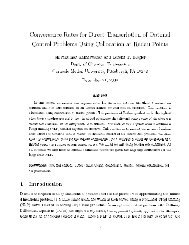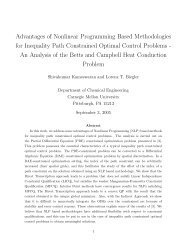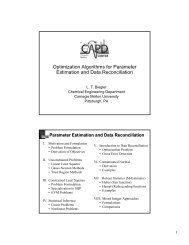MPEC Problem Formulations in Chemical Engineering Applications
MPEC Problem Formulations in Chemical Engineering Applications
MPEC Problem Formulations in Chemical Engineering Applications
You also want an ePaper? Increase the reach of your titles
YUMPU automatically turns print PDFs into web optimized ePapers that Google loves.
Objective SBB CONOPT-PF IPOPT-CNFE Function CPU s. CPU s. Iterations CPU s. Iterations10 1.4738 0.242 0.047 15 0.110 17100 1.7536 50.266 0.234 78 1.250 411000 1.7864 410.195 9.453 680 28.406 782000 1.7888 >6000 35.359 1340 14.062 253000 1.7894 — 112.094 2020 106.188 844000 1.7892 — 211.969 2679 84.875 565000 1.7895 — 340.922 3342 199.391 876000 1.7898 — 468.891 3998 320.140 1157000 1.7896 — 646.953 4655 457.984 1418000 1.7898 — 836.891 5310 364.937 98Table 2: Solution times (Pentium 4, 1.8 GHz, 992 MB RAM) for differentsolution strategiesdynamic tray columns [14, 20, 23]. In these studies smooth<strong>in</strong>g methods andregularization methods were applied for distillation optimization, with the refluxratio, feedtray location and tray number as decision variables. In this section, werevisit these steady state distillation optimizations for the sake of a performancecomparison, particularly with the penalty formulation, PF(ρ).Here we def<strong>in</strong>e distillation column models that consist of MESH (Mass balance,Equilibrium, Summation, and Heat balance) equations that are modifiedto optimize the feed tray location and total tray count. As shown <strong>in</strong> Figure4, streams for the feed and the reflux are fed to all trays as dictated by twodiscretized Gaussian distribution functions. As developed and described <strong>in</strong> [14],both distribution functions are def<strong>in</strong>ed by a mean and standard deviation. Forthe feed and reflux distributions, their means represent the feedtray locationand the total number of trays, respectively, and these are used as cont<strong>in</strong>uousdecision variables <strong>in</strong> the distillation optimization. We also choose a standarddeviation of 0.5, so that distribution flow to trays away from the mean tapersoff smoothly to negligible values. Moreover, the grayed area <strong>in</strong> Figure 4 consistsonly of vapor traffic, and consequently, each tray model must <strong>in</strong>clude complementaritiesthat allow for disappearance of the liquid phase. As described <strong>in</strong>Section 5.6, phase equilibrium is relaxed by the complementarity constra<strong>in</strong>ts:y ij = β i K ij x ijβ i = 1 − s l i + sv i(49a)(49b)0 ≤ L i ⊥ s l i ≥ 0 (49c)0 ≤ V i ⊥ s v i ≥ 0 (49d)where i = {1, 2, . . .,N max } and N max is the maximum number of equilibriumstages, j is the component <strong>in</strong>dex, L i and V i are the liquid and vapor flow rateon tray i, and x and y are the respective mole fractions.The result<strong>in</strong>g complementarity distillation model is an alternative nonl<strong>in</strong>-22






